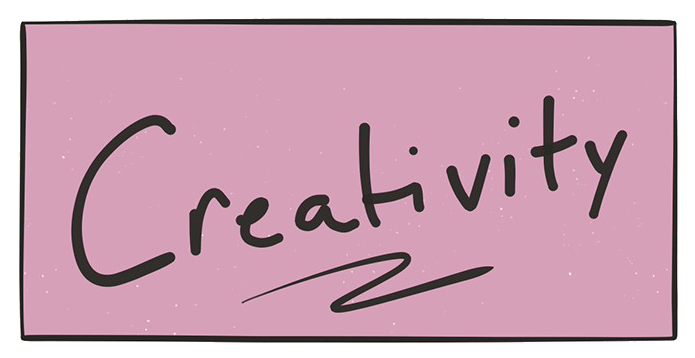As part of my Masters Degree, I researched and wrote a paper on the use of social media technologies in teaching and learning. I looked specifically at how it might relate to constructivist teaching pedagogy, and specifically, if social media could be an effective tool for assisting students in knowledge building and meaning-making activities. This post is third in a series examining the five main themes that I discovered in my research. The first post can be found by clicking here.
3 – Creativity
The traditional format of taking notes, studying, and then parroting information during an exam is well embedded into traditional learning systems, both in schools, and online. While this system continues to work, educators are excited to find new ways of encouraging learning. The addition of creativity to this list of strategies in using social media is derived from studies in constructive learning, and also in activity theory. Activity theory is used as a framework in this sense, described commonly through the saying, “you are what you do” (Nardi, 1996, p. 7). It is through committing to understanding and processing new information through activity, that learners can assimilate and build new knowledge. Such activity is not carried out by rote or as a disembodied action, but as “doing in order to transform something” (Barab, Evans, & Baek, 2004, p. 200). This aligns quite well with the use of social media tools, because as Leont’ev proposed,
the human individual’s activity is a system of social relations. It does not exist without those social relations
(Leont’ev, 1981, pp. 46-47).
Surely we have all seen instances where students become engaged in a school project, and they become more invested in not only the outcome, but in their own interest in the subject matter as well. I think of a nephew who, as I sit down to dinner with him, recounts all kinds of interesting and detailed information about dinosaurs. This knowledge comes to him through his engagement and ‘creating’ with the topic. Not only that, but in his social recounting of the information to a third party (me, as his uncle), he is required to know the material well enough to be confident to portray it cogently. In this example, for learners at a younger age, I equate ‘play’ as being aligned to activity theory in processing new information. In this way, constructive learning benefits from and is well aligned with activity, and throughout both, there is this overall benefit to the learner in interacting socially. This leads very well into tasks requiring creativity.
Constructivist learning entails a required participation from the learner into constructing their own knowledge. For example, in a study by Heafner & Friedman (2008), grade 11 students that created wikis for a school project demonstrated greater understanding and retention than peers who learned through teacher instruction. The recent emphasis on integrating maker culture and systems into classrooms is another example of building learning successes through creativity. I find it interesting that while arts & crafts are more accepted in younger grades, we ‘wean’ students away from this type of creative learning as they get older. Even as an adult, I still feel that I learn more when I try to build or create something myself. This is not to imply that everyone learns the same way; it would be folly to think that creative endeavours could completely replace focused study. But with modern access to today’s social media tools, it’s a great opportunity to make decisions about when to use it and how it can best serve particular learning situations.
One thing I keep reminding myself is that the goal is to encourage learners to become creators, not memorizers. The goal to get learners creating artifacts of learning, stimulating ideas through construction while resolving cognitive conflict. Imagine students building knowledge and taking control of the subject matter, not simply absorbing it like a sponge, but interacting with it, turning it over in their minds, creating with it. Connections. In this respect, social media tools can be used to great effect. Get your students making wikis, audio editing, video creation, building infographics (piktochart.com), or using online software to help create poster boards (canva.com). There’s even a site where students can create a (fake) Facebook page for historical or fictional characters (http://www.classtools.net/FB/home-page). Teachers have also had students use Twitter to create fictional re-enactments of world events, as seen through historical figures, as recounted in this study (Jensen, Caswell, Ball, Duffin, & Barton, 2010): http://openaccess.uoc.edu/webapps/o2/bitstream/10609/4942/6/Caswell_editat.pdf and with examples at http://twhistory.org/
Regardless of the tools you choose, get the learners using social media to create, not just parrot information. Allow them to play with the subject matter, and leverage the power of curiosity to boost their success!
Come back Monday for part 4: Self-Mediation
References
Barab, S. A., Evans, M. A., & Baek, E.-O. (2004). Activity theory as a lens for characterizing the participatory unit. Handbook of Research on Educational Communications and Technology, 2, 199–213.
Heafner, T. L., & Friedman, A. M. (2008). Wikis and constructivism in secondary social studies: Fostering a deeper understanding. Computers in the Schools, 25(3-4), 288–302. http://doi.org/10.1080/07380560802371003
Jensen, M., Caswell, T., Ball, J., Duffin, J., & Barton, R. (2010). TwHistory : Sharing History Using Twitter. In Open ED 2010 Proceedings. Barcelona: UOC, OU, BYU. Retrieved from http://hdl.handle.net/10609/4942
Leont’ev, A. N. (1981). The problem of activity in psychology. In J. V. Wertsch (Ed.), The Concept of activity in Soviet psychology. Armonk, NY: M.E. Sharpe.
Nardi, B. A. (1996). Activity theory and human-computer interaction. In B. A. Nardi (Ed.), Context and consciousness: Activity theory and human–computer interaction (Vol. 436, pp. 7–16).

Pingback: Using Social Media Interactivity to Encourage Learning | Learning and Technology
Comments are closed.